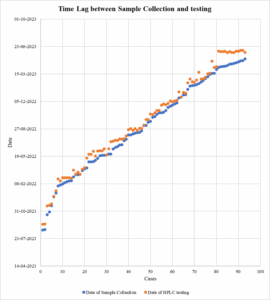Research Article | Vol. 6, Issue 1 | Journal of Clinical Medical Research | Open Access |
Stability of Blood Samples for Sickle Cell Disease Detection: An Examination for Extended Storage Period
Anna Salomi Kerketta1*




2ICMR – National Institute of Immunohaematology, Mumbai, India
*Correspondence author:Anna Salomi Kerketta, ICMR – Regional Medical Research Centre, Bhubaneswar, India;
Email: [email protected]
Citation: Kerketta AS, et al. Stability of Blood Samples for Sickle Cell Disease Detection: An Examination for Extended Storage Period. Jour Clin Med Res. 2025;6(1):1-4.
Copyright© 2025 by Kerketta AS, et al. All rights reserved. This is an open access article distributed under the terms of the Creative Commons Attribution License, which permits unrestricted use, distribution, and reproduction in any medium, provided the original author and source are credited.
| Received 03 April, 2025 | Accepted 21 April 2025 | Published 28 April, 2025 |
Abstract
Introduction: Sickle Cell Disease (SCD) is particularly widespread among the tribal communities in India. Under the National Sickle Cell Elimination Program it is screened through Point-Of-Care (POC) tests at local centers, followed by HPLC confirmation at district hospitals. The transportation and storage of samples from remote areas frequently lead to delays in testing. Aim: To assess the stability of blood samples utilized for the identification of sickle cell disease, particularly examining how prolonged storage time influence SCD diagnosis.
Methods: In an ICMR taskforce multicentric study, 8,385 cord blood samples were collected in EDTA tubes from public health facilities of various blocks in the Kandhamal district of Odisha. The samples were kept at 4-8°C and transported to the District Headquarter Hospital for HPLC analysis. Initial 300 samples underwent immediate POC testing using Hemotype SC and confirmatory molecular testing was performed for all HPLC-positive cases.
Results: A total of 93 SCD-positive (HbSS) cases were detected through HPLC and validated via molecular analysis. 6 cases were tested ≤4 days and 87 cases were tested >4 days with a mean of 23.0 ± 13.4 days, and the samples remained viable for diagnosis for up to 61 days when kept refrigerated.
Conclusion: Cord blood samples maintained at 4-8°C are stable for as long as 61 days without compromising SCD diagnosis, which facilitates sample transport and enhances the feasibility of large-scale screening in remote areas.
Keywords: Sickle Cell Disease; Case Detection; Blood Sample Stability; Extended Storage Period
Introduction
Sickle Cell Disease (SCD) is an inherited blood disorder which results in the production of abnormal Haemoglobin which then adversely affects the life of a person due to various morbidities and sometimes can lead to death too [1]. India has one of the highest burden of SCD in the world with most of the cases prevalent in the tribal population [2]. Various methods used for diagnosis of SCD has been mentioned by Arishi WA [3]. High pressure liquid chromatography is the most suitable approach to detect haemoglobin S and other haemoglobins [4]. Under the Sickle cell anemia elimination program, the screening is being done at Ayushman Bharat Health and Wellness centres using paper-based point of care device. The confirmatory test needs to be done at district level using HPLC [5]. Since the tribal people reside in remote rural areas it is difficult to come for confirmatory HPLC test at the District Headquarter Hospital (DHH). If a sample is collected from the periphery, it raises concerns among technicians performing the test regarding storage temperature, transportation conditions and the time lag between sample collection and testing that hinders timely clinical decision making [6]. These factors can affect the ability to measure HbA2 levels in the blood sample for diagnosing sickle cell disease. Therefore, we aimed to study the maximum allowable time lag between sample collection and testing while ensuring the reliability of HbA2 level measurement for sickle cell disease diagnosis.
As a part of a multicentric extramural study, we conducted screening for SCD by testing for homozygous state of HbS in newborns in different blocks of Kandhamal district of Odisha, India. The district has a significant tribal population and the blocks are scattered in about 80 to 120 km radius from the District Headquarter Hospital (DHH) where the screening test was done using HPLC.
Ethical Statement
The project was approved by institutional human ethics committee and state research and ethics committee.
Methodology
The cord blood samples collected from the delivery points like CHCs and PHCs in tubes containing EDTA, and were transported to the DHH. But the transfer of blood samples was done only after a significant number of samples were collected due to transportation feasibility and cost consideration. After collection, the samples were stored in the refrigerator at temperatures between 4° C to 8° C at the CHCs and PHCs. Even after the samples reached the DHH, the testing could not be done immediately due to several other operational issues. For initial 300 samples screening was done using a Point of Care device (POC) i.e. Hemotype SC to compare the accuracy, specificity and sensitivity of the device [7]. All the samples were subjected for HPLC using Bio Rad D10 Dual Programme machine, which had shown accuracy in identifying spectrum of haemoglobinopathies in central India at different time points [8]. The SCD positive samples were sent to National Institute of Immunohaematology (NIIH), Mumbai for molecular analysis.
Results
We collected 8385 cord blood samples. The POC detected 6 SCD positives, which were also identified in HPLC done within 61 days (2 months) after sample collection. These results were also corroborated with molecular analysis. We detected 93 SCD positive (HbSS) cases by HPLC, which were also identified by the molecular analysis. 87 cases were tested after 4 days, the average time lag from sample collection and testing was 23±13.4 days. That indicates the stability of blood samples in refrigeration for up to 61 days for Sickle cell detection (Fig. 1).

Figure 1: Time lag between sample collection and testing for SCD.
Discussion
As per the guidelines of the BIO RAD D10 dual program HPLC device, the blood samples would have remained stable for 4 days when stored at 2° C to 8° C for obtaining the best results. Several studies in the past have stated that blood samples stored at temperatures between 4° C to 8° C are stable for testing for parameters for up to 72 hours [9]. HbA2 stability at room temperature for 15 days was reported by Bento, et al., and Mercadanti, et al., [10,11]. However, Mercadanti, et al., reported higher temperature interfering with its stability.
Conclusion
The study highlighted that beyond the recommended period for testing, up to 61 days after sample collection, while storing blood samples at 4-8°C for SCD diagnosis, did not adversely affect the test results. However, proper maintenance of temperature and storage conditions is essential. Therefore, stored blood samples can be used for testing to detect and confirm SCD under the programme, reducing logistical challenges related to time, manpower and other concerns.
Conflict of Interest
The authors declared no potential conflicts of interest with respect to the research, authorship and/or publication of this article.
Acknowledgement
We sincerely thank ICMR for sponsoring the study, the State Health and Family Welfare Department, Government of Odisha, for the approval and support, the patient’s families for their participation, and all the healthcare staff, technicians, and field workers for their dedication.
Consent to Participate
Informed consent was obtained from the parents of the new born before sample collection.
Financial Disclosure
The study was funded by ICMR, extramural.
Data Availability
Data is available for the journal.
Author’s Contribution
Anna Salomi Kerketta: Conceptualization, methodology design, manuscript writing, and editing.
Padmavati Majhi: Manuscript writing and editing.
Narayana Swamy DM: Data analysis, data validation, and interpretation of results.
Oshin Warerkar: Molecular analysis and manuscript editing.
Anita Nadkarni: Manuscript editing and critical revision.
References
- Johns Hopkins Medicine. Sickle cell disease. Baltimore: Johns Hopkins Medicine. 2025. [Last accessed on: April 21, 2025] https://www.hopkinsmedicine.org/health/conditions-and-diseases/sickle-cell-disease
- National Health Systems Resource Centre. Tribal health in India: detailed report. New Delhi: NHSRC. 2018. [Last accessed on: April 21, 2025]
- Arishi WA, Alhadrami HA, Zourob M. Techniques for the detection of sickle cell disease: A review. Micromachines. 2021;12(5):519.
- Colah RB, Wadia M, D’Souza E, Sawant PM, Mohanty D, Mehra M. Evaluation of a capillary blood collection system for screening for haemoglobinopathies in remote areas. Int J Lab Hematol. 2008;30(1):57-63.
- Ministry of Health and Family Welfare. Guidelines for national programme for prevention & management of sickle cell disease: National Sickle Cell Anaemia Elimination Mission. New Delhi: MoHFW. 2023.
- Larkins MC, Thombare A. Point-of-care testing [Internet]. Treasure Island (FL): StatPearls Publishing. 2025.
- Steele C, Sinski A, Asibey J, Hardy-Dessources MD, Elana G, Brennan C, et al. Point-of-care screening for sickle cell disease in low-resource settings: a multi-center evaluation of HemoTypeSC, a novel rapid test. Am J Hematol. 2019;94(1):39-45.
- Sehgal S, Khan S, Jetley S, Alvi Y. Evaluation of abnormal hemoglobin variants and hemoglobinopathies on D-10 analyzer – an institutional experience from North India. Online J Health Allied Scs. 2022;21(2):10.
- Hildrum JM, Fjeld B, Risahagen SM, Bernatek BJ, Klingenberg O. Assessment of hemoglobin A2 stability at room temperature during 24 or 25 days as measured by high pressure liquid chromatography and capillary electrophoresis. Int J Lab Hematol. 2021;43(4):e266-70.
- Bento C, Relvas L, Vazao H, Campos J, Rebelo U, Ribeiro ML. The use of capillary blood samples in a large scale screening approach for the detection of beta-thalassemia and hemoglobin variants. Haematologica. 2006;91(11):1565.
- Mercadanti M, Romero A, Lippi G. The measurement of hemoglobin A2 and F in stored whole blood samples. Clin Lab. 2011;57(9-10):777-80.
Author Info
Anna Salomi Kerketta1*




2ICMR – National Institute of Immunohaematology, Mumbai, India
*Correspondence author:Anna Salomi Kerketta, ICMR – Regional Medical Research Centre, Bhubaneswar, India;
Email: [email protected]
Copyright
Anna Salomi Kerketta1*




1ICMR – Regional Medical Research Centre, Bhubaneswar, India
2ICMR – National Institute of Immunohaematology, Mumbai, India
*Correspondence author:Anna Salomi Kerketta, ICMR – Regional Medical Research Centre, Bhubaneswar, India;
Email: [email protected]
Copyright© 2025 by Kerketta AS, et al. All rights reserved. This is an open access article distributed under the terms of the Creative Commons Attribution License, which permits unrestricted use, distribution, and reproduction in any medium, provided the original author and source are credited.
Citation
Citation: Kerketta AS, et al. Stability of Blood Samples for Sickle Cell Disease Detection: An Examination for Extended Storage Period. Jour Clin Med Res. 2025;6(1):1-4.



